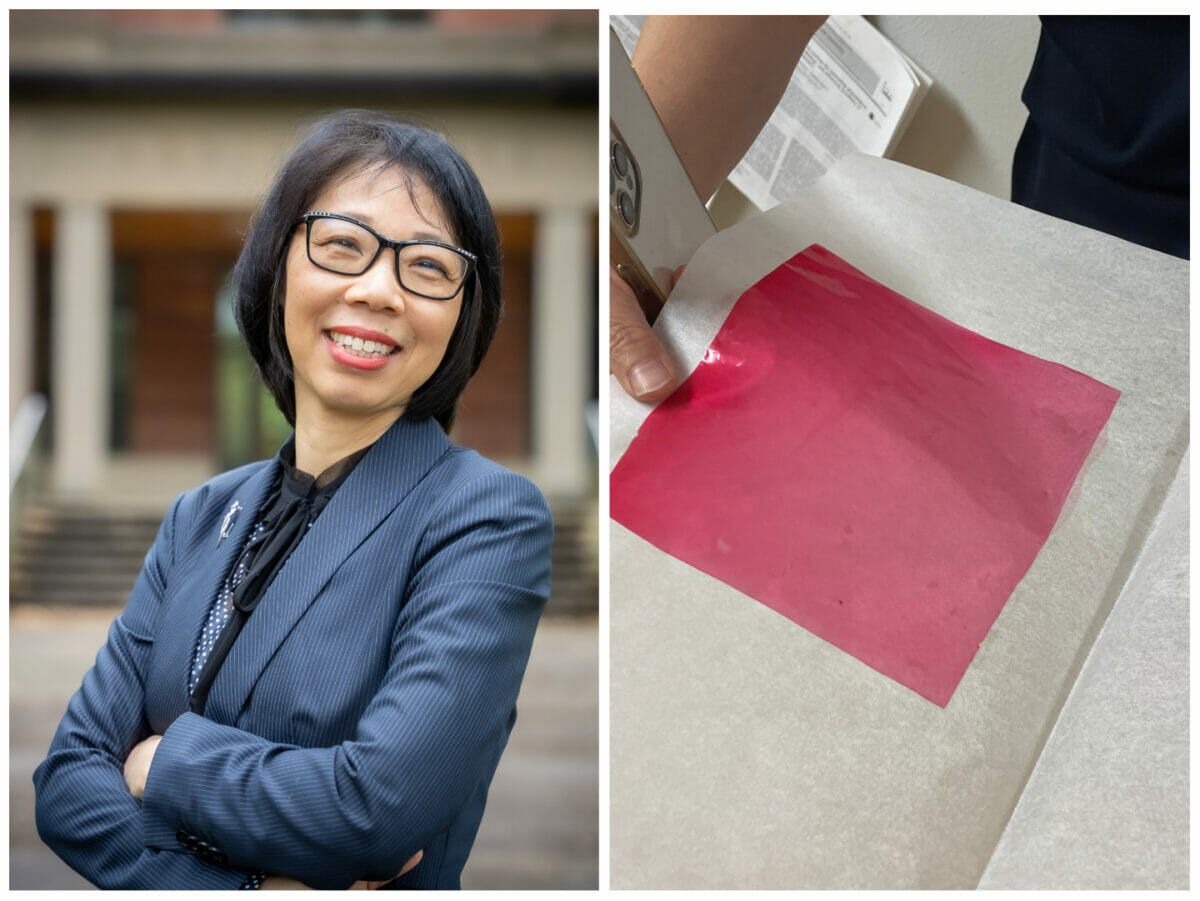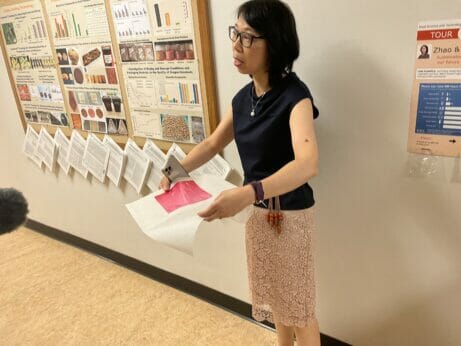Could Dissolvable Cranberry Film Replace Plastic Packaging Someday?
The technology to use biodegradable film in place of some plastic or paper packaging is there, say researchers. But first, the industry needs to get on board.
Could Dissolvable Cranberry Film Replace Plastic Packaging Someday?
The technology to use biodegradable film in place of some plastic or paper packaging is there, say researchers. But first, the industry needs to get on board.

Dr. Yanyun Zhao (left), and a sample of the cranberry filmPhotography by Ben Davis, OSU
Imagine making a bowl of oatmeal or a cup of instant ramen noodles. You likely rip open a plastic package and fish out the little sachet of desiccant destined to be thrown away before pouring the rest of the contents into a bowl.
But what if you could toss the whole package directly into the bowl with your boiling water, saving yourself a bit of fuss and another piece of waste? Yanyun Zhao hopes we’ll see that option become more widely available soon.
Zhao, a professor of food science at Oregon State University, has researched material compositions and applications since 2008. That’s when cranberries first caught her eye. While visiting a juice company’s production facilities, she spotted the remains of pressed cranberries being carted off to use in animal feed or compost.
But to Zhao’s eye, the squashed berries still had a lot of value as a fibrous substance. “I brought some back to the lab, and in our weekly meeting, displayed it to the students,” says Zhao. She put a challenge out to her grad students and colleagues: What can we make with this? “You can imagine all sorts of ideas we came up with.”
Of all the ideas presented, creating a fibrous film that is edible, no-waste, anti-microbial and water soluble was the one that took off, and Zhao published her first paper on the subject 15 years ago. Since then, she’s continued to tweak and refine the formulation.
The film itself looks like a pale strip of fruit leather. It’s mostly tasteless, although there could be a version with a stronger flavor, as it’s completely edible. It’s made by taking the cranberry pomace—or the residue that’s left over once the juice has been pressed out—and mixing that with other food polymers. “When you’re making this film, you need stretch, you need elasticity, you need a lot of functionalities. So, we incorporate other functional food, like other carbohydrates, a little bit of glycerin,” Zhao explains. The end result is a moveable, stretchable, completely biodegradable film.

The film could someday replace traditional packaging materials, but that’s not the only factor that makes it so appealing. It’s also anti-microbial. The cranberry film can work as a replacement for film plastic, protecting fruits and vegetables with delicate skins, such as English cucumbers. Zhao says there could even be a version of the film strong enough to hold liquids, although that requires more study and experimentation.
Currently, Zhao is working on a version of the natural film that could replace paper cupcake and muffin liners, which actually perform a complex task. The liners have to hold a damp batter without dissolving, and then go into a hot oven without melting or losing shape. “We’ve produced these edible cup liners. You can consume them as part of your muffin or you can peel them off and compost them,” says Zhao. The only real hiccup to mass producing these cranberry-based films comes down to cost. “Since those liners are so cheap, people might not care. I can get 100 cupcake liners for a couple of dollars. But if you’re really sensitive to promoting sustainability, we do have the technology there. We are able to achieve this goal.”
The real test will be if companies and manufacturers are willing to switch up production and packaging standards to incorporate new, environmentally friendly materials. Over the pandemic, as more people ordered takeout, there was a rise in plastic and non-compostable containers, which created more waste for our cities. Before COVID-19, many cities moved towards banning single-use plastics, such as plastic bags, but the pandemic slowed that progress. But as folks are still interested in takeout, some experts think there’s a timely opportunity to update food storage options. Zhao says that’s why industry and researchers should work closely together.
“There’s not a perfect product yet. How can we reduce the cost? How can the formulations and technology more easily scale up through companies?” says Zhao. “But the future is very bright for me, because there’s more consumer education, which is important.” One day soon, you might just bite into your muffin liner or dissolve your instant coffee right in its package. Until then, this might make you look at that Thanksgiving cranberry sauce a bit differently.
Follow us
This work is licensed under a Creative Commons Attribution-NoDerivatives 4.0 International License.
Want to republish a Modern Farmer story?
We are happy for Modern Farmer stories to be shared, and encourage you to republish our articles for your audience. When doing so, we ask that you follow these guidelines:
Please credit us and our writers
For the author byline, please use “Author Name, Modern Farmer.” At the top of our stories, if on the web, please include this text and link: “This story was originally published by Modern Farmer.”
Please make sure to include a link back to either our home page or the article URL.
At the bottom of the story, please include the following text:
“Modern Farmer is a nonprofit initiative dedicated to raising awareness and catalyzing action at the intersection of food, agriculture, and society. Read more at <link>Modern Farmer</link>.”
Use our widget
We’d like to be able to track our stories, so we ask that if you republish our content, you do so using our widget (located on the left hand side of the article). The HTML code has a built-in tracker that tells us the data and domain where the story was published, as well as view counts.
Check the image requirements
It’s your responsibility to confirm you're licensed to republish images in our articles. Some images, such as those from commercial providers, don't allow their images to be republished without permission or payment. Copyright terms are generally listed in the image caption and attribution. You are welcome to omit our images or substitute with your own. Charts and interactive graphics follow the same rules.
Don’t change too much. Or, ask us first.
Articles must be republished in their entirety. It’s okay to change references to time (“today” to “yesterday”) or location (“Iowa City, IA” to “here”). But please keep everything else the same.
If you feel strongly that a more material edit needs to be made, get in touch with us at [email protected]. We’re happy to discuss it with the original author, but we must have prior approval for changes before publication.
Special cases
Extracts. You may run the first few lines or paragraphs of the article and then say: “Read the full article at Modern Farmer” with a link back to the original article.
Quotes. You may quote authors provided you include a link back to the article URL.
Translations. These require writer approval. To inquire about translation of a Modern Farmer article, contact us at [email protected]
Signed consent / copyright release forms. These are not required, provided you are following these guidelines.
Print. Articles can be republished in print under these same rules, with the exception that you do not need to include the links.
Tag us
When sharing the story on social media, please tag us using the following: - Twitter (@ModFarm) - Facebook (@ModernFarmerMedia) - Instagram (@modfarm)
Use our content respectfully
Modern Farmer is a nonprofit and as such we share our content for free and in good faith in order to reach new audiences. Respectfully,
No selling ads against our stories. It’s okay to put our stories on pages with ads.
Don’t republish our material wholesale, or automatically; you need to select stories to be republished individually.
You have no rights to sell, license, syndicate, or otherwise represent yourself as the authorized owner of our material to any third parties. This means that you cannot actively publish or submit our work for syndication to third party platforms or apps like Apple News or Google News. We understand that publishers cannot fully control when certain third parties automatically summarize or crawl content from publishers’ own sites.
Keep in touch
We want to hear from you if you love Modern Farmer content, have a collaboration idea, or anything else to share. As a nonprofit outlet, we work in service of our community and are always open to comments, feedback, and ideas. Contact us at [email protected].by Emily Baron Cadloff, Modern Farmer
November 14, 2022
Modern Farmer Weekly
Solutions Hub
Innovations, ideas and inspiration. Actionable solutions for a resilient food system.
ExploreExplore other topics
Share With Us
We want to hear from Modern Farmer readers who have thoughtful commentary, actionable solutions, or helpful ideas to share.
SubmitNecessary cookies are absolutely essential for the website to function properly. This category only includes cookies that ensures basic functionalities and security features of the website. These cookies do not store any personal information.
Any cookies that may not be particularly necessary for the website to function and are used specifically to collect user personal data via analytics, ads, other embedded contents are termed as non-necessary cookies.
I would pay more for take out to cover the cost of these containers!
This is amazing! I can’t wait to see where this goes. What an incredible invention.
This is intriguing!
Can see using the product, but not sure if I would eat it.
What plant is this article talking about? You have a picture of one plant Initially introducing the article Which I think is about another plant but itwhich never explains which plant you’re talking about.